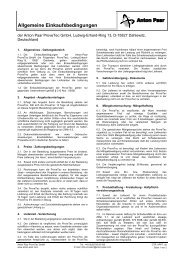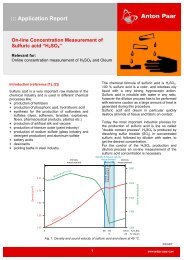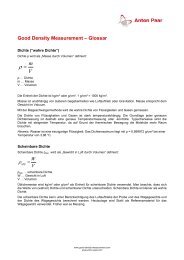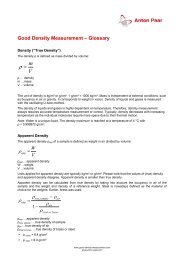On-line Concentration Measurement of Sulfuric acid - Anton Paar.com
On-line Concentration Measurement of Sulfuric acid - Anton Paar.com
On-line Concentration Measurement of Sulfuric acid - Anton Paar.com
You also want an ePaper? Increase the reach of your titles
YUMPU automatically turns print PDFs into web optimized ePapers that Google loves.
::: Application Report<br />
<strong>On</strong>-<strong>line</strong> <strong>Concentration</strong> <strong>Measurement</strong> <strong>of</strong><br />
<strong>Sulfuric</strong> <strong>acid</strong> “H2SO4”<br />
Relevant for:<br />
<strong>On</strong><strong>line</strong> concentration measurement <strong>of</strong> H2SO4 and Oleum<br />
<strong>Concentration</strong> determination <strong>of</strong> sulfuric <strong>acid</strong><br />
The concentration <strong>of</strong> aqueous solutions <strong>of</strong> sulfuric<br />
<strong>acid</strong> is quoted as % w/w H2SO4.<br />
Figure 1 shows the density/concentration and sound<br />
velocity/concentration relationship for sulfuric <strong>acid</strong> at<br />
40°C.<br />
The concentration <strong>of</strong> oleum <strong>of</strong> different strength is<br />
quoted according to the content <strong>of</strong> "free SO3" in<br />
100 % sulfuric <strong>acid</strong>; thus oleum-40 contains 40 % <strong>of</strong><br />
free SO3 in 100 % sulfuric <strong>acid</strong> (this corresponds to<br />
an equivalent concentration <strong>of</strong> 109 % H2SO4 as the<br />
result <strong>of</strong> a titration).<br />
% free SO3<br />
0<br />
10<br />
20<br />
30<br />
40<br />
50<br />
60<br />
70<br />
Equivalent %<br />
H2SO4<br />
100.00<br />
102.25<br />
104.50<br />
106.75<br />
109.00<br />
111.25<br />
113.50<br />
115.75<br />
To achieve highest accuracy, the physical property<br />
(density or sound velocity) which shows the biggest<br />
change upon change in sulfuric <strong>acid</strong> concentration<br />
should be employed for the determination <strong>of</strong><br />
% H2SO4.<br />
0-90 % w/w<br />
Density measurement should be used to calculate<br />
H2SO4 concentration from 0 to 90 % w/w, because<br />
density has a steep and almost <strong>line</strong>ar dependence<br />
on the <strong>acid</strong> concentration.<br />
2<br />
90-100 % w/w<br />
Sound velocity should be used to determine the<br />
H2SO4 concentration in the range <strong>of</strong> 90 to 100 %<br />
w/w, since it is strongly influenced by a<br />
concentration change whereas density changes<br />
only very little in this range.<br />
0-25 % w/w oleum<br />
In the oleum range from 0 to 25 % free SO3,<br />
density measurement should be utilized again to<br />
calculate the H2SO4 concentration.<br />
90-110 % w/w<br />
To measure over the 100 % concentration, a<br />
density and sound velocity signal is needed. <strong>On</strong>ly<br />
by <strong>com</strong>bination <strong>of</strong> 2 physical independent signals<br />
this measurement range is possible!<br />
Typical installation sites<br />
Double contact process<br />
The starting material for the production <strong>of</strong> sulfuric<br />
<strong>acid</strong> is sulfur dioxide (SO2), which is produced by<br />
<strong>com</strong>bustion <strong>of</strong> sulfur or roasting <strong>of</strong> sulfur<br />
containing ores.<br />
Sulfur dioxide is reacted with oxygen (oxidized)<br />
to give sulfur trioxide. This reaction occurs at four<br />
to five vanadium oxide contacts. After the third<br />
contact most <strong>of</strong> the formed SO3 is removed from<br />
the reaction mixture and fed into the first<br />
absorber. The residual reaction <strong>com</strong>ponents<br />
(SO2 and O2) are again reacted at the vanadium<br />
oxide contacts. The formed SO3 is fed into the<br />
second absorber.












